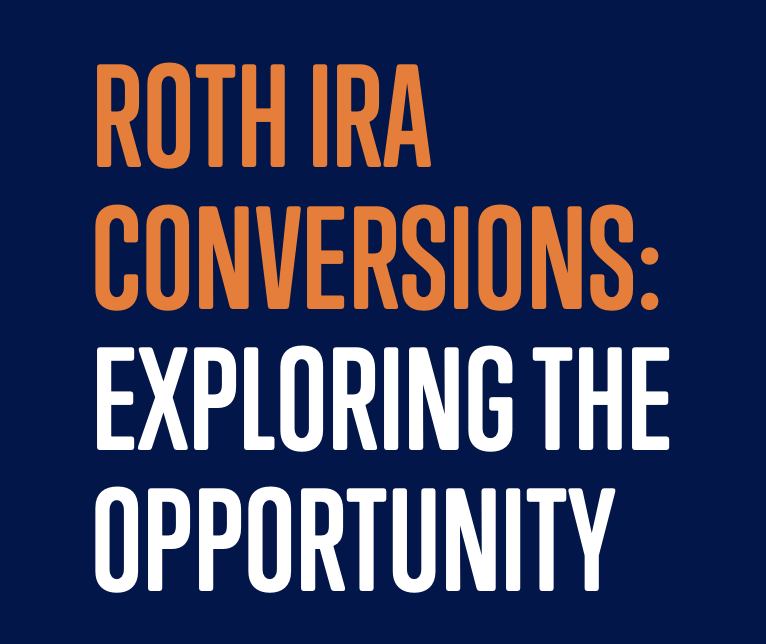
A Roth IRA (Individual Retirement Account) is a type of retirement savings account that offers tax advantages to investors. A typical account allows you the flexibility to invest in a diverse range of assets, including stocks, bonds, mutual funds, and more. Compared to a traditional IRA, Roth IRAs offer some unique features.
With a traditional IRA, you’re able to make contributions that are tax deductible and you can roll over employer retirement plans funded with pre-tax dollars to IRA accounts. With a Roth IRA, you make contributions with after-tax dollars and you’re not eligible for any immediate tax benefits or deductions. However, withdrawals from a Roth IRA are tax-free as long as you are over age 59½ and have held the account for at least 5 years.
Deciding which IRA is right for you depends on whether you think you’ll be in a higher or lower income tax bracket at time of withdrawal (after age 59½). If you anticipate being in a higher bracket in retirement, you may prefer a Roth IRA. If you think you’ll be in the same or a lower income-tax bracket in the future, a traditional IRA may make more sense.
OTHER UNIQUE ADVANTAGES OF A ROTH IRA INCLUDE:
PAGE 2
A Roth IRA conversion involves transferring funds from a traditional IRA, 401(k), or other tax-deferred retirement account into a Roth IRA.
BE AWARE OF THE TAX IMPLICATIONS
Whatever amount you convert to a Roth IRA will be subject to income taxes for the year of the conversion. The taxes will be calculated based on your marginal income tax bracket and the amount of money you convert from your traditional IRA or employer plan assets.
There are tax implications of doing a Roth IRA conversion, particularly if you are converting traditional IRA or employer plan assets that include both deductible and nondeductible contributions. It may be prudent to consult with a CPA or other tax professional to help you determine the taxation on the conversion based on your situation.
OTHER CONSIDERATIONS
Roth Conversion Limits. There are no dollar limits when converting from a traditional IRA or employer plan to a Roth IRA. The IRS does impose annual limits on contributions to Roth IRAs (for example, the annual limit is $7,000 for 2024, plus another $1,000 if over age 50).
Roth Conversion Deadline. The annual deadline for a Roth conversion is December 31 (the IRS does not allow extensions).
Future Tax Rates. Consider your expected future tax rates. If you anticipate being in a higher tax bracket during retirement, a Roth conversion may be more advantageous. If you anticipate being in a lower tax bracket, it may not make sense for you.
Impact on Other Benefits. For those in retirement, it’s important to find out if the additional taxable income from a conversion could affect means-tested benefits, such as Medicare premiums. Consider consulting with a financial professional on how the conversion may impact your overall financial picture.
Recharacterization. The option to “recharacterize” a Roth IRA conversion (undo the conversion) was eliminated by tax law changes that went into effect January 1, 2018. You’ll want to be absolutely sure a conversion to a Roth IRA is right for you.

PAGE 3
As you weigh the pros and cons of making a Roth IRA conversion, here are some additional things to keep in mind.
A ROTH IRA CONVERSION LIKELY MAKES SENSE IF:
A ROTH IRA CONVERSION MAY NOT BE APPROPRIATE IF YOU:
HOW TO PERFORM A ROTH CONVERSION
If you decide a Roth IRA conversion is right for you, there are several ways to accomplish the conversion:
No matter which method you use, the IRS will collect the federal tax you owe when you file your tax return for the year of the conversion. Your IRA custodian will report the conversion as a distribution on Form 1099-R and the Roth contribution on Form 5498.

PAGE 4
1. CONSIDER TIMING
The best time to convert from a traditional to a Roth IRA is generally when the market is down and your traditional IRA or employer plan has lost value, your income is unusually low for the year, your itemized deductions have increased, or any combination of these factors.
2. MANAGE TAXES EFFECTIVELY
Consider converting in stages over multiple years to manage tax implications and avoid moving into a higher tax bracket.
3. EVALUATE YOUR FINANCES
Assess your current and future financial situation, including expected tax rates, to determine if a conversion aligns with your financial goals.
4. CONSULT WITH YOUR LPL FINANCIAL PROFESSIONAL
Your LPL financial professional can provide guidance to help you understand the tax implications, potential benefits, and optimal timing for a Roth IRA conversion. In addition, they can make sure the investment portfolio within the Roth IRA aligns with your risk tolerance and long-term financial objectives.
5. COVER CONVERSION TAXES
Use funds outside the retirement account to pay taxes resulting from the conversion. Using the converted funds for taxes may impact potential tax-free growth.
A Roth IRA conversion is a strategic financial move that can offer tax advantages and diversify your retirement savings. Your LPL financial professional is always available to help you consider the implications and determine if a conversion aligns with your long-term financial goals.

----
Sources: “Roth IRA Conversion: Here’s Everything You Need to Know Before Converting” (Bankrate.com, September 5, 2023); Converting Your Traditional IRA to a Roth IRA (Fidelity.com, accessed 10/11/23); “IRA FAQs: How Do I Convert My Traditional IRA to a Roth IRA?” and “Rollovers of Retirement Plan and IRA Distributions (Internal Revenue Service); “Bad Stock Market? Good Time for a Roth IRA Conversion” (Investopedia.com, 8/4/22).
This material was prepared by LPL Financial, LLC.
Securities and advisory services offered through LPL Financial (LPL), a registered investment advisor and broker-dealer (member FINRA/SIPC). Insurance products are offered through LPL or its licensed affiliates. To the extent you are receiving investment advice from a separately registered independent investment advisor that is not an LPL Financial affiliate, please note LPL Financial makes no representation with respect to such entity.
This material is for educational and informational purposes only and is not intended as ERISA, tax, legal or investment advice. If you are seeking investment advice specific to your needs, such advice services must be obtained on your own separate from this educational material.
RP-871-0124 Tracking #533624 (Exp. 02/25)